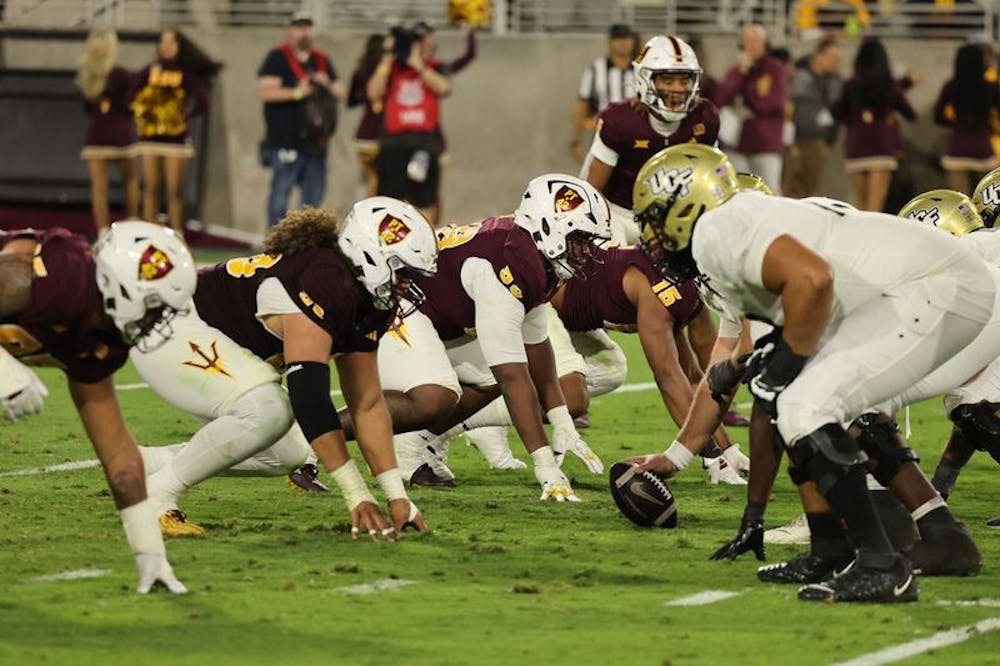There's a stat that's turning the tide for ASU football that almost no one knows about.
It's called the Middle Eight.
This stat takes the last four minutes of the first half and the first four minutes of the second half and looks at how many points a team scores during that period. Coaches often cite the Middle Eight as an important factor in games, and ASU head coach Kenny Dillingham is no exception.
"It's the difference maker," Dillingham said.
Through nine games, the Sun Devils have outscored their opponents 63-13 in the Middle Eight. In four of ASU's victories this season, a positive scoring differential in the Middle Eight has been the deciding factor between a win and a loss.
The statistic originates from legendary NFL head coach Bill Belichick and has been seen as a key differentiator in close games due to its situational prowess — if teams can score at the end of the first half, receive the ball to begin the second half, and score again, that's a huge point swing.
However, Dillingham didn't get the idea from Belichick. Instead, he got it from Oregon head coach Dan Lanning when he was an offensive coordinator with the Ducks.
"When I was with Dan (Lanning), he harped on it to me," Dillingham said. "I always knew about it, but I really started to believe in it. If you look at those games at Oregon, we actually led the country that year, when I was the offensive coordinator there, in the Middle Eight."
Why is it important?
When executed correctly, the Middle Eight can effectively act as a "natural turnover" in any given game, because it gives the offense another possession without the defense having to get a stop.
"Every other time you score, you give the ball back to the opponent, other than when you score at the end of the half," Dillingham said. "They don't have enough time to score. That's a natural possession you gained in the game, which, to me, is a turnover."
An effective Middle Eight period can also stagnate the opposing offense. Between an offensive possession at the end of the first half, the 20-minute break at halftime, and another offensive possession to begin the second half, the opposing team's offense can be kept off the field for over an hour of real-time.
That long of a period without reps can easily get an offense out of rhythm.
"The Middle Eight is more of a defensive philosophy because the defense doesn't want to have to go back on the field," Dillingham said.
How has ASU been so successful in the Middle Eight?
ASU's success in the Middle Eight has been largely due to two factors — offensive scoring at the end of the first half and defensive dominance in the middle period of games.
Offensively, the group led by redshirt freshman quarterback Sam Leavitt has scored eight touchdowns with four minutes or less in the first half this season. In fact, seven of those touchdowns have occurred with less than two minutes to go in the second quarter.
"I didn't really know too much about it before the season, but we've done such a good job this year, and we've stressed it so much," Leavitt said. "It's been the key to so many victories, so I definitely see the importance of it now. Our last minutes before the end of the first half, we've put up points almost every single time. I can't remember a time that we haven't scored when we've had the ball."
READ MORE: Fast starts, scripted plays are keys to ASU's offensive success this season
On defense, the group led by defensive coordinator Brian Ward has given up only 13 points in the Middle Eight minutes of games this season. That's occurring in more than 70 minutes of game time.
Such success is in part due to Ward's ability to make halftime adjustments.
"We made a decision coming out of the half, 'hey, we're going to play a new game,'" redshirt junior defensive back Xavion Alford said after ASU won the Middle Eight by 14 points in its victory against Texas State. "And ultimately, in the second half, we played our football."
Overall, the Sun Devils' Middle Eight dominance is just another example of the changing culture in Tempe. Players have bought into the Middle Eight, as they have for many of Dillingham's philosophies.
ASU's second-year leader doesn't mince words when describing the Middle Eight's importance.
"Game-changing," Dillingham said.
Edited by Henry Smardo, Abigail Beck and Madeline Schmitke.
Reach the reporter at jwkartso@asu.edu and follow @kartsonis3 on X.
Like The State Press on Facebook and follow @statepress on X.
Jack is a sophomore studying sports journalism. This is his second semester with The State Press. He has also worked at other student journalism organizations.




